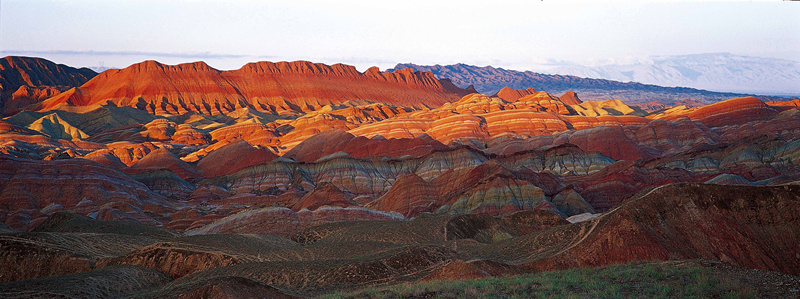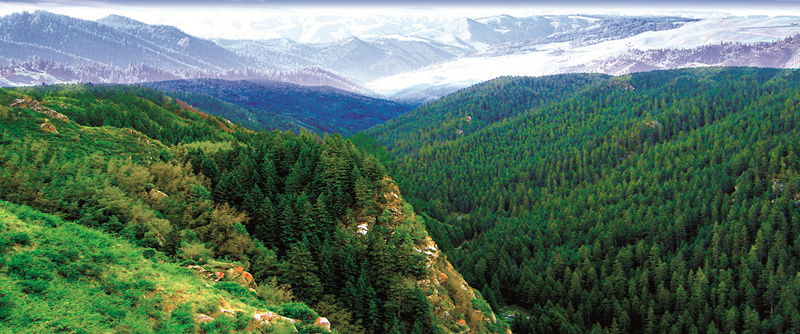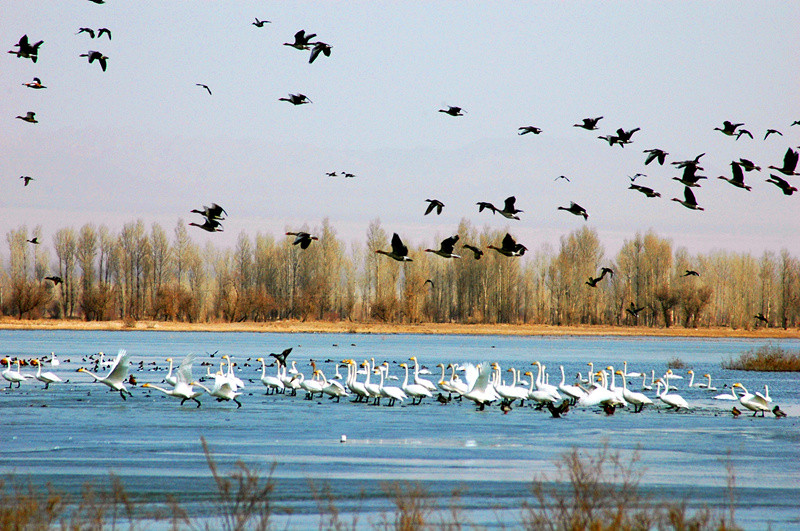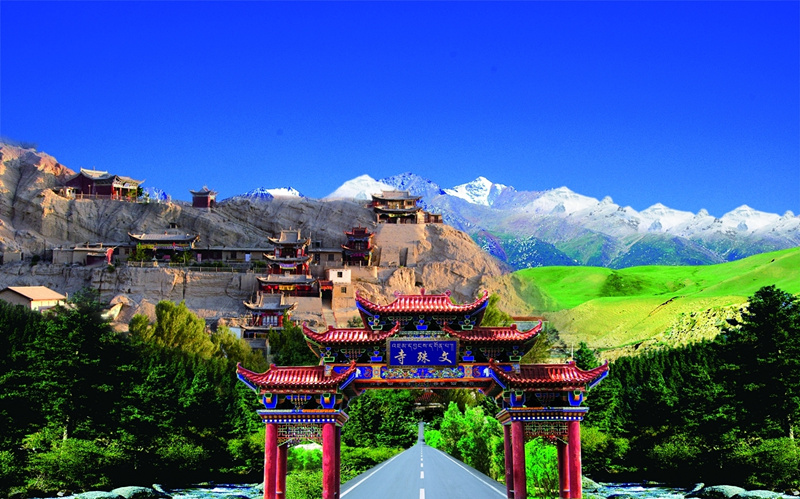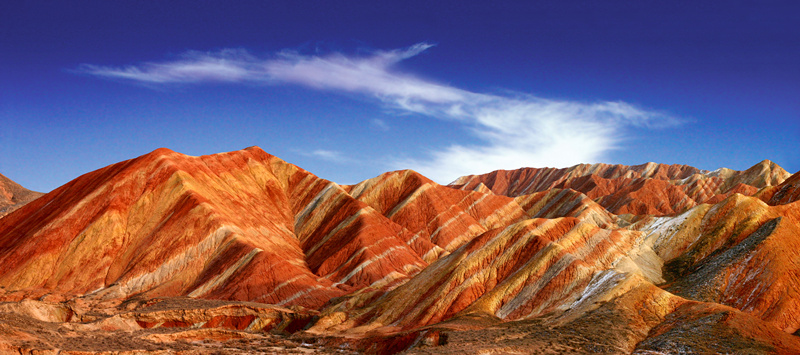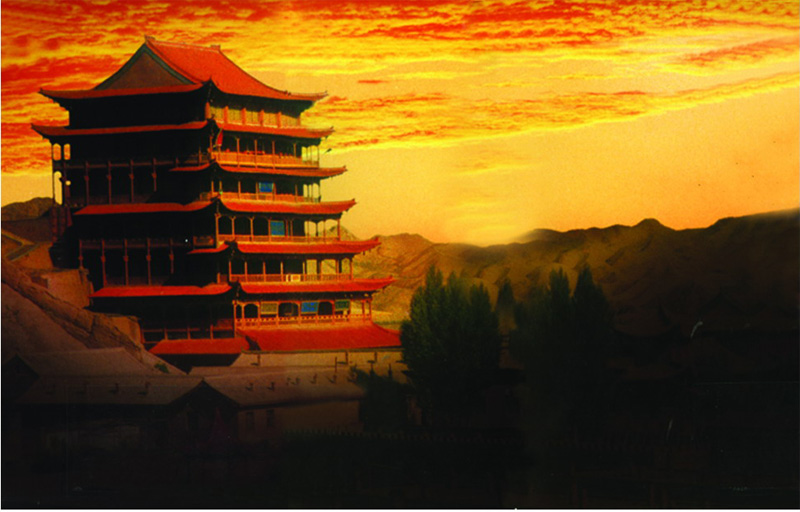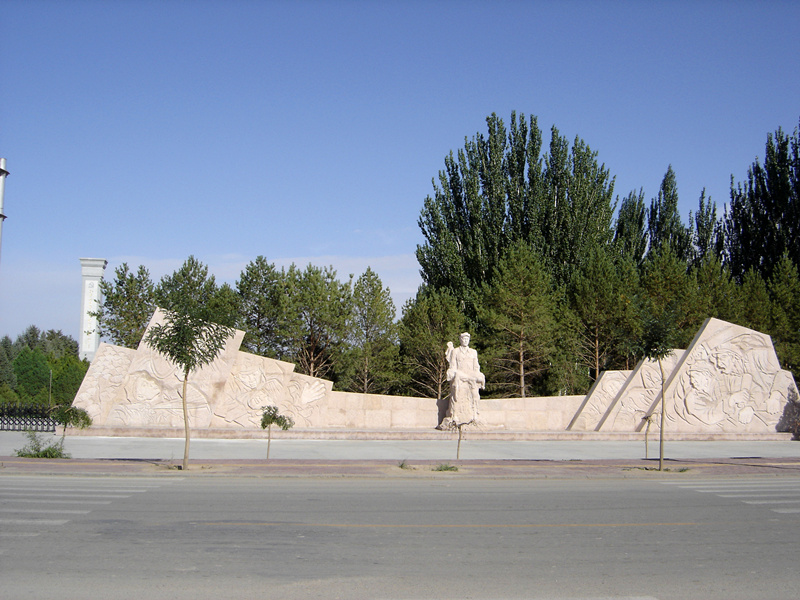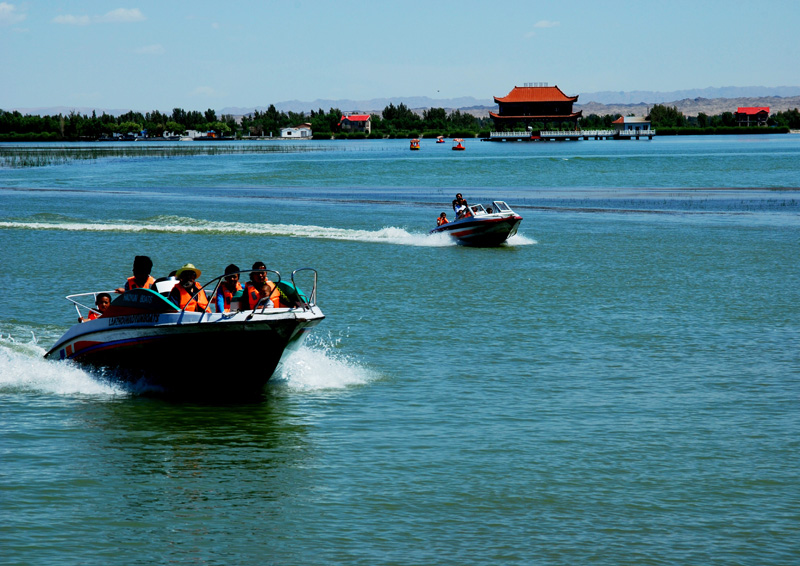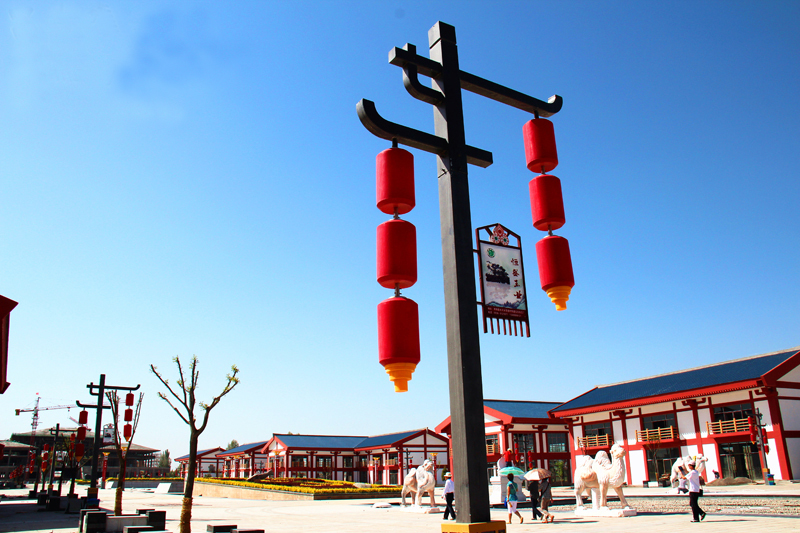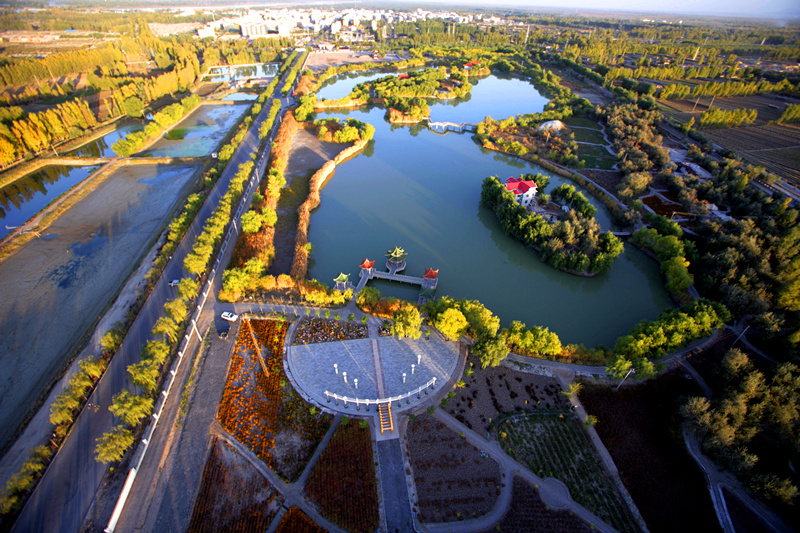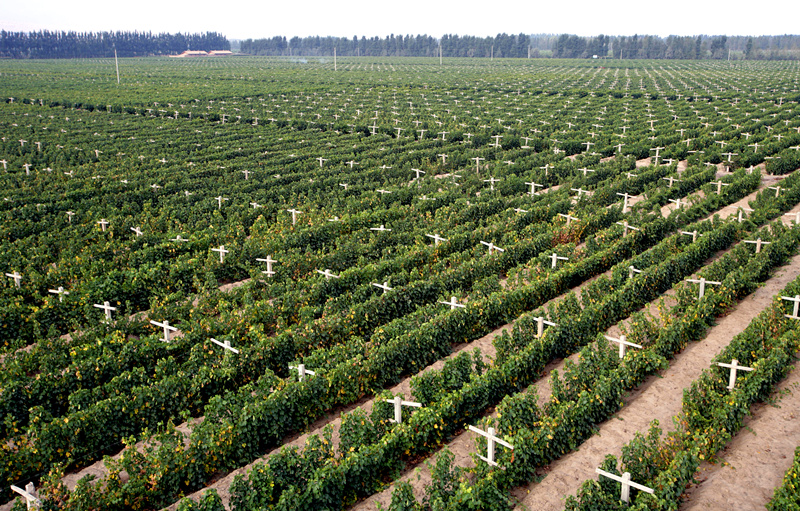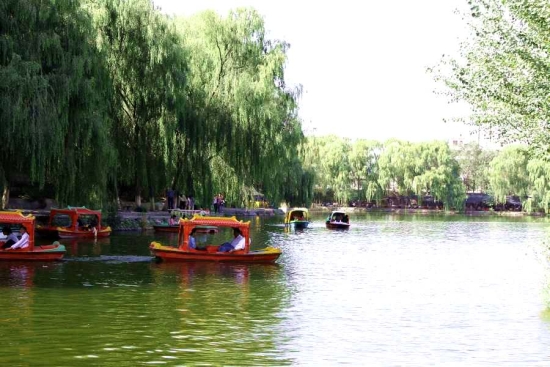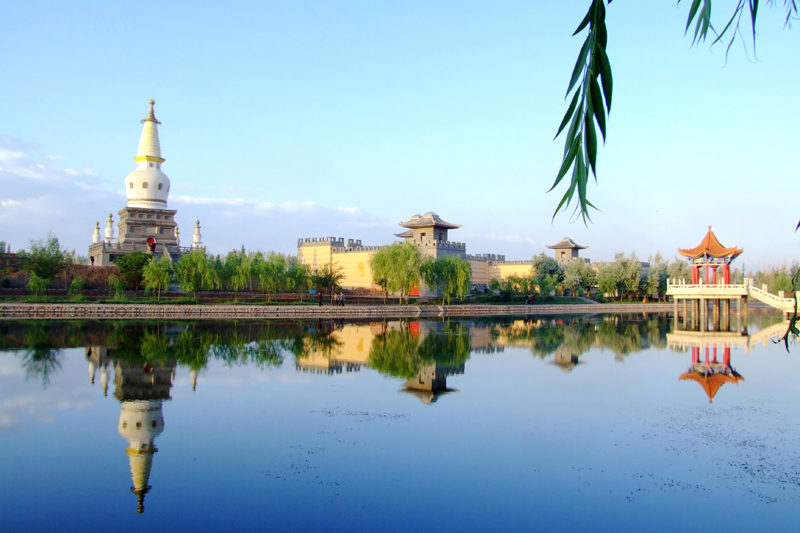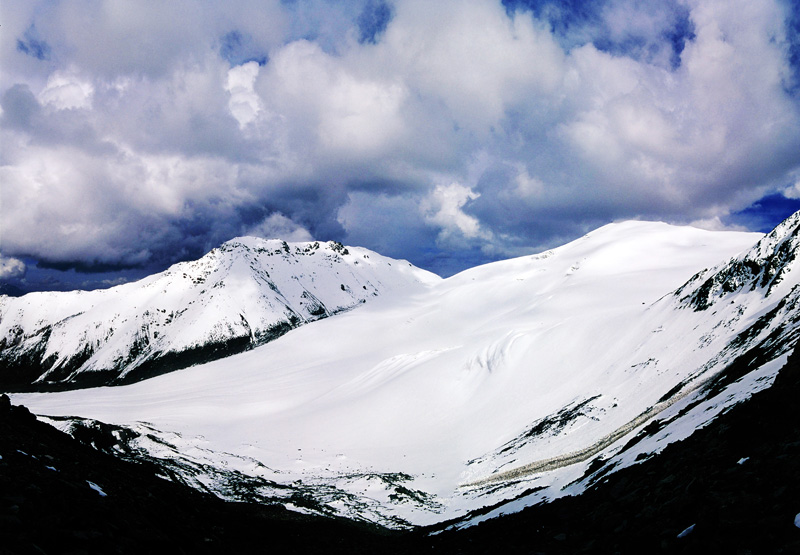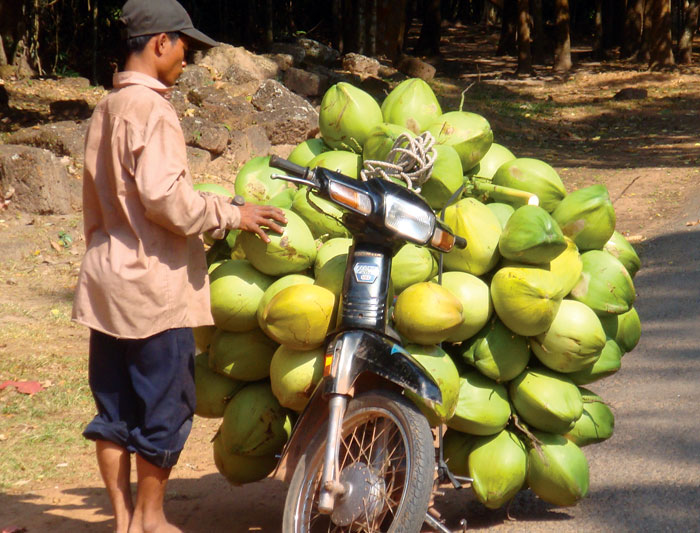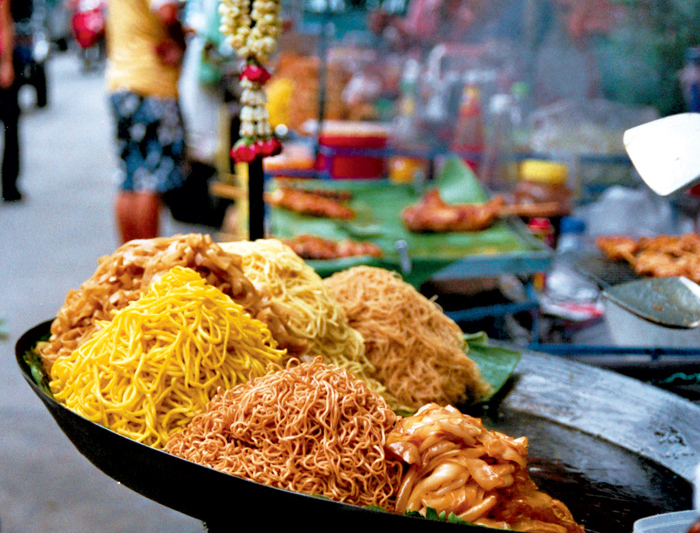Zhangye City
Zhangye is located in the northwest of Gansu Province and the middle section of the Hexi Corridor. It gets its name for the words “Stretch the Country’s arms out to reach the Western Region". In ancient times it was also called “Ganzhou" from which Gansu Province gets its name. It has always enjoyed the reputation of “The Land of Mulberry and Hemp" and “The Land of Milk and Honey". The City covers an area of 40,874 km2. Its total population is 1.2105 million. Ganzhou District, Linze, Gaotai, Shandan Minle Counties and Yugur Autonomous County of Sunan are under its jurisdiction. In the south of Zhangye is Qilian Mountain; north is Heli Mountain and Longshou Mountain. Heihe River runs through the whole area. All of these combine to form a unique oasis. With the nourishment of Heihe River, the second continental river in China, a broad oasis is bred, and consequently the culture of the Hexi Corridor is bred. Zhangye is favorably endowed by nature: incredible urban wetland, Danxia Landform, the most beautiful Rape flower Ocean in the Northwest, the largest army horse ranch in the world, unique Yugur nationality flavor, Qilian Mountain’s wildness, and ice-covered peaks in the Gobi. Snow, ice, woods, grassland, lakes, and sands contrast finely with each other. The area has the austral charm as well as the frontier flavor, hence the verse “Lose sight of the snow on Qilian Mountain, and Zhangye would be mistaken for the South." Zhangye abounds in resources and has great potential for development. It is the New Eurasian Land Bridge’s thoroughfare linking up east to west transportation in China, and one of important areas in nation’s Western Development. The whole area has 2667 km2 of farmland (including Shandan Army Horse Ranch); 2000 km2 of arable wasteland; 26 rivers whose annual runoff is 26.2 bcm, and hence a rich groundwater storage; 17333 km2 of grasslands. 9.2% of the area is forested with 3867 km2 of forests. It has an average of 3000 hours of sunshine annually. Most of the area is flat, with fertile lands, thick forests and abundant grains. The climate here is continental and dry. The annual average temperature is 6℃. January is the coldest month, and July is the hottest one. The best tourist season lasts from June to September each year. Zhangye is a city having two state-level nature reserves, and also a city situated on the wetland. It is renowned as “An Abundant Place Beyond the Frontier" with green mountains, clean waters, azure sky and grassy lands; as a “City of Wetland" it is livable, travelable and suitable for studying; as a “Cooling City" clear and clean; and as a “Water Region in the Gobi" civilized, harmonious and prosperous. From ancient times, it has enjoyed the good name of “Gold Zhangye, Silver Wuwei". It has the largest army horse ranch in Asia, state-level wetland reserve and Zhangye National Geopark voted one of “The Top Ten Magic Geographical Wonders" by American National Geographic. The Buddhist Temple (AAAA)
The Buddhist Temple, located in the southwest corner of Zhangye City, gets its name from the largest indoor Reclining Buddha in China. Being the landmark building in Zhangye, the historical and cultural city, it is one of the most important historical places along the Silk Road, and a key historical and cultural site under the protection of the state. The Temple, whose original name was Kasyapa Buddha Temple, was built in 1098 A.D., and is the largest remnant of Xixia buildings in Gansu province. In the scenic area some spots are opened to the public: The Buddhist Temple built in the Xixia regime, Longevity Wooden Tower built in the Sui Dynasty, Amida Thousand-Buddha Pagoda and Bell and Drum Tower built in the Ming Dynasty, and Shanxi Guild Hall whose fame resounded throughout the Northwest. The Buddhist Temple (the place of the Ganzhou District Museum), the major part of the scenic area, is a renowned Buddhist temple in the Northwest, having the name of “Famous monastery on the frontier, Buddhist Wonderland in the world." The temple has the largest wooden framed and clay-modeled Reclining Buddha in China. The sculpture is 34.5 meters tall, with 7.5 meters in shoulder breadth, 2 meters in ear, and 4 meters in foot. It is covered by gold and colorfully painted, vivid and lifelike. The Temple is magnificent and grand. The special-styled sculpture, abundant scrolls and relics are closely related to Xixia royalty. The Temple’s building style, sculpture, wood engravings, inscriptions, plaques and legends are valuable for the study of architectural history, ethnic culture and religious culture in ancient Hexi and the whole Western Region. Sunan Horse’s Hoofs Temple (AAAA)
Horse’s Hoofs Temple, 165 km southeast to the Sunan County, is a tourist area combining grotto art, the scenery of Qilian Mountain, and the flavor of Yugur nationality. It gets the name because of the heavenly horse’s hoofs’ print which is kept in the Horse’s Hoofs Hall of Puguang Temple and is treasure of the Temple. The environment around the scenic area is picturesque. Green mountains, clear water, odd peaks and unusual caves are “Four Wonders" in the area. The average altitude here is about 2580 meters. The annual average temperature is 1-3℃. The area has 67 km2 of forests, most of which are spruce and juniper. The main mountains are Wild Ox Mountain, Zhengnangounao Mountain, Dieshui Mountain, Daguanxing Mountain, Dadumahenao Mountain, and Dragon Mountain. The main rivers are Dayekou River, Suyoukou River, Xiaoduma River, Daduma River, Haichaoba River, Heniukou River, Hoof River, and Flood River. Linsong Falls run all the year round. Horse’s Hoofs Grottoes, a Historic site built in the Jin Dynasty, divided into Gold Tower Temple, Up, Middle, and Down Kwan-Yin Cave, South and North Horse’s Hoofs Temple, is a historical and cultural site under the protection of the state. It is a tourist attraction combining cultural landscape, natural scenery and ethnic customs. Visitors can live in the Yugur’s tent, drink barley wine, and eat mutton with hands to experience the living style and customs of nomads. Yanzhi Mountain Forest Park (AAAA)
Yanzhi Mountain Forest Park, 45 km southeast to the Shandan County, is separated by Army Horse Prairie with the Qilian Mountain. It covers an area of 680 km2. The average altitude here is about 2919 meters. The Park is a scenic area of natural beauty. It is also known as “Rouge Mountain" because juice of a plant in the mountain has a close likeness to rouge which the local women applied on their lips and brows. The park, shadowed by evergreen cypress trees, full of verdant grass, twittering birds and fragrant flowers, is beautiful and charming and has enjoyed the good name of “Another Mount Huang". Up the mountain are boundless woods; below the mountain are green valleys and fast-flowing streams. In the heartland of forests, roes and badger sheep are numerous. On both sides of the valley are steep cliffs, and odd stones. During summer and autumn, red Lilium pumilums blossom all over the place. In the Park there are the site of Zhongshan Temple, built during the reign of Emperor Xuanzong of the Tang Dynasty, the site of World Exposition, the reconstructed sacred site Jade Emperor Hall and Buddha Hall, and one of the “Ten Views of Shandan"——“Morn Sun of Shandan". Li Bai, the famous poet of the Tang Dynasty, left the verse “Albeit living in Yanzhi Mount, I feel not the chill of winter." Shandan Yanzhi Mountain Temple fair is held annually on 6th day of the sixth lunar month. The Fair is a grand occasion teeming with tourists when it is mid-summer and bright and breezy. Now the Park is an absolute must and desired spot on the Silk Road Tourist Route. Zhangye National Wetland Park (AAAA)
Zhangye National Wetland Park is in the north of outskirt of the Ganzhou District of Zhangye City and joined with urban area. The Park is at longitude 100°06′—100°54′ east, latitude 40 degrees north. The wetland covers an area of 17.3 km2. Its main part is at groundwater overflow zone in the northern suburbs. It is the wetland nearest to the city. Zhangye National Wetland Park is situated in the middle reaches of Heihe River, Qilian alluvial fans area front, phreatic overflow zone of the ancient channel and flood plains of Heihe River. The Park is a compound wetland ecosystem constituted by natural wetlands such as rivers, herb marshes and moist meadows, as well as artificial wetlands such as artificial lakes, ponds and canals. Types of wetland here are various; and its original ecological characteristics are outstanding. It is recorded that Zhangye has had the name of “Water Dreamland of the north of Ganzhou" since ancient times. Lakes and springs found everywhere in downtown and northern suburbs form the 20-km2 wetland system. Qifeng Manjushri Temple Grottoes Scenic Spot (AAAA)
Manjushri Temple Grottoes Scenic Spot, in Qifeng Tibetan Township of Sunan County of Zhangye, faces the ancient Silk Road, backs against to Qilian Mountain, and adjoins with Jiuquan the historical site of The Western Han Dynasty and Jiayuguan, the mighty pass. The grottoes, a key historical and cultural site under the protection of the state, are built during the reign of Emperor Ming of the Eastern Jin Dynasty and now 1,500 years old. Manjushri Mountain Grottoes, one of Liangzhou patterns, are the remains of early Buddhism in China. They are valuable for studying Buddhist art in Sixteen Kingdoms Period and for connection of Buddhist architecture and art between the Hexi area and the Western Region. Its frescoes have the layout features of early grotto frescos in the Hexi area. Some of them have the advantages over the Mogao Grottoes’, while others are continuation and development of the Mogao Grottoes’. The existing frescoes painted in Xixia period are valuable material for studying Buddhism and Buddhist painting during that time. Hall of Five Hundred arhats is unique in Hexi Area. Manjushri Temple Grottoes Scenic Spot has numerous cultural remains, rich ethnic flavor and tourism resources. Tourists here can appreciate Tibetan, Yugur and Mongolian customs when visiting, and have much enjoyment. Zhangye Danxia GeoPark (AAAA)
Zhangye Danxia GeoPark, at the north foot of Qilian Mountain, 30 km to the south Linze County, is the only compound district of Danxia landform and colorful hills in China, which has a value of scientific research and sightseeing and is voted as one of “The Most Beautiful Danxia Landform". In China, total number of Danxia Landform is 790. Their distributions are centered in 26 provinces in the southeast, the southwest as well as arid areas in the sorthwest where Danxia landform in Zhangye is the most typical and the largest one, and also one of the areas whose growth is the best and models are the richest. Thousands of cliffs and hills here all appear bright rouge and reddish-brown, presenting a marvelous Danxia landform——“splendid like Lilium concolor Salisb, bright like rosy clouds". In local minority language this striking scenery is described as “Rouge Mountain". Many movies, such as the famous movie director Zhang Yimou’s A Simple Noodle Story, and Jiang Wen’s The Sun Also Rises, were shot here. Shandan Big Buddha Temple Scenic Spot (AAAA)
Shandan Big Buddha Temple, located at the foot of Liaogao Mountain 5 km to the west Shandan County, is a temple with a long standing reputation. Its former name was “Clay Buddha Temple" and was built in the Northern Wei Dynasty (425 A.D.). So it is believed to be 1,500 years old. The largest indoor clay-modeled Sitting Buddha is set in the Temple. Zhu Qizhen, the emperor Ying of the Ming Dynasty autographed a plaque “Clay Buddha" for the Temple, hence the name. The Temple survived many wars, and was reconstructed several times. In 1971, the Temple was almost destroyed completely during the “Cultural Revolution". At the beginning of 1992, Master Shijuehui, the abbot, begged around and got the support and finance from Master Shengyi, the famous Buddhist activist of Po Lin Monastery in Hong Kong. Shandan Big Buddha Temple finally was reconstructed at a cost of 17 million yuan. In 1998, the Temple was consecrated formally. On 8th day of the fourth lunar month, a traditional temple fair would be held at the Big Buddha Temple. The festival lasted for hundreds of years and achieved peak in the Qing Dynasty, but henceforth on the wane. Since the 1990s, the traditional temple fair has been reopened by Shandan County People’s Government. The folk festival is a blend of folk art, local customs, and Buddhist culture. In the wonderful festive atmosphere, visitors can experience the charm of Shandan folk customs. Gaotai West Route Red Army Monument (AAAA)
Gaotai West Route Red Army Monument is located in Gaotai County. It is enjoying the name of “An Abundant Place Beyond the Frontier, Ancient Capital of the Northern Liang". Its precursor was Gaotai Martyrs’ Cemetery built in 1953. Now the Monument covers an area of 17 hectares. More than 3,000 revolutionary martyrs lie buried here, such as Dong Zhentang, the army commander of the Fifth Red Army who fought in Hexi, and died in Gaotai; Yang Keming, the director of the Political Department. The Monument is a key martyrs memorial building under the protection of the state, and commemoration, exhibition, protection and study center of the history of West Route Red Army as well. The Monument is well equipped and solemnly arranged. There is the service center, an entrance door, series of sculptures at the door, “Bloody Battle" the martyrs’ sculpture group, the cenotaph, the memorial cemetery, and the memorial hall. At the north and south side of the front yard two three-eave doubled-layered five-cornered pavilions are built symmetrically. At the north and south side of the cenotaph are the memorial pavilions of Dong Zhentang and Yang Keming. Cypress trees are planted among the buildings to create a fine environment. Now the Monument is the most comprehensive and the most authoritative place reflecting the history of West Route Red Army. Corridor of Yugur Flavor (AAAA)
Corridor of Yugur Flavor is situated at the Yugur Autonomous County of Sunan. Its overall length is 80 km. Being the main component of Zhangye National GeoPark, it is a comprehensive landform park blending snow-covered mountains and glaciers, virgin forests, natural grasslands, wetlands and lakes, falls and rivers, canyons and valleys, as well as a Danxi landform. In virtue of Qilian Mountain’s view, based on culture and history, centering on the Yugur flavor, the scenic area takes advantage of the vastness of Danxia landform, the wildness of grassland, and the calmness of the forests to present visitors the unique, mystic and wild Yugur culture and history. The scenic area highlights the purity of Qilian Mountain and mystic variety of Yugur culture through four aspects——“Yugur Impression", “Yugur History", “Yugur Flavor", and “Yugur Glory". It is a scenic area of multi-functions——Geo-Sightseeing, Eco-Vacationing, and Recreation——based on sightseeing in Qilian Mountain, exploring ethnic history, and experiencing Yugur customs. Visitors can enjoy a picturesque travelling and know about the history. The Great Lake Bay Scenic Area in Zhangye City(AAAA)
The Great Lake Bay scenic area, located in the middle of the Silk Road 70 km to the west Zhangye City, covers an area of 7 km2. The area is, with an advantageous geographic location and charming natural scenery——in the south, Qilian Mountain Ranges are like a silver snake; in the north, the Ruoshui River is bickering——a comprehensive natural scenic area blending agricultural irrigation, recreation and traveling, as well as aquiculture. The scenic area is situated at the agricultural hinterland of Gaotai County and surrounded by the wild farmlands, forests and grassland. Because the area is low-lying, it abounds with water and fertile soil suitable for the growth of plants. Its vegetation coverage is 95% and is a place where “green and lush is grass, fine and verdant are trees". The superior environment and pleasant climate attract various birds to inhabit and breed here thus contributes to the exuberant vitality of the scenic area. On the lake there is antiqued “Dragon Court" which is also known as “Dragon Palace", richly ornamented and magnificent. With the change of climate, “Dragon Court" becomes distinct or shrouded by the mists. The scenery is even better than fairyland Penglai. Various fish for ornament and savor are one of the tourism projects and satisfy the fishing demand of tourists. The Great Lake Bay scenic area, with green water, azure sky, and rural viewing, builds an exotic sight in the Hexi Corridor. Yushui Garden in Zhangye City (AAAA)
Yushui Garden, situated in the Qilian Jade Culture Industry Park north to the Binhe New District of Zhangye City, is a major part of the New District. In the garden, classical buildings are well arranged and delicate in ancient style. Walking through the Garden is a fascinating tour. Yushui Garden centers on Qilian Jade, integrating the culture, architecture, jade, stones, green water and plants into the natural scenery. As a modern park, it has multi-functions: Qilian Jade culture spreading, academic communication, sightseeing and recreation. It unites Qilian Jade processing, trading and appreciation into one as well. Gaotai Crescent Lake Park (AAA)
Crescent Lake Park lies 1 km from the western outskirts of Gaotai County. It covers an area of 37 hectares, among which 12 hectares are water. The surface of the lake is divided by five isles connected by curved, arch and level bridges. The Park is built according to the topographic features of the wetland. Thus the original ecological environment is preserved. The lake is surrounded by thickly growing reeds, weeping willows, well-arranged pavilions and distinctive waterside houses. Isles in the lake are connected by curved, arch and level bridges. Winding trails are lined with shady trees. The park is really a good place for recreation and exercising. Qilian Wine Estate in Gaotai County(AAA)
Qilian Wine Estate, at Nanhua Town in Gaotai County, covers an area of 2158.32 hectares. It consists of three zones: the grape plantation, the horticulture and science garden, and the wine production zone. The Estate is the golden location for the growing of wine grapes in China. According to the different functions of the zones, Exhibition Hall is built to propagate enterprise culture, to display wine, and for sightseeing. The production zone of 180 thousands km2 is afforested and beautified. The tourism facilities such as bridges, the grape corridor, the central fountain, and the pavilion in the production zone are perfected. Thus tourist function of the Estate is enhanced. Now it is an eco-tourist resort combining scientific study, fieldwork, recreation, sightseeing, dining and entertainment. Zhangye Sweet Spring Park (AAA)
Zhangye Sweet Spring Park, situated at the north end of the Xianfu North Street, gets its name from historical site “Sweet Spring" in Zhangye. The park covers an area of 20 hectares. There are two doors at both ends of the North-south axis in the park. The south door is the front door, facing to the Xianfu North Street. The north door faces the Huancheng North Road. The doors are linked by a wide path. The outstanding style of the park is that the center is water which is surrounded by hills and winding paths. The park is based on the artistic concept of nature, peace and seclusion. There are 28 scenic spots in the park, such as the East and West lakes, Children’s Garden, Arboretum, Sisters Pavilion, Isle at Heart of the Lake, Youth Center, and so on. In the park, cypresses are ever green, flowers are everywhere, pavilions are facing each other, water is mirroring hills, and willows are weeping. It is the biggest comprehensive urban park for recreation and sightseeing in Zhangye City. Shandan South Lake Ecological Arboretum (AAA)
Shandan South Lake Ecological Arboretum, located at the south of Shandan County, is a forestry garden expanding new species of flowers and plants, and a scenic area integrating history and natural landscape. The Arboretum, built in 1982, now covers an area of 200 thousand km2. This is a new comprehensive garden combining sightseeing, recreation and catering with more than 20 scenic spots, 10 amusement items. In the Arboretum, there is Fata Temple, Evergreen Garden, Zhualun Pavilion, and Zhaowen Hall. According to ancient legend, the Fata Temple was one of 84,000 towers built by Ashoka the Great (there were 19 in China). Nothing remained of the original tower after thousands of years. In the Ming Dynasty, a reconstructed tower was built on the base of the old one. Later it was destroyed by earthquakes and man-made misfortunes. In 2004, a new tower was built in the south of the Arboretum with financing. The Fata Tower, in the form of a bottle, is more than 17 meters high with a 7-meter high base. The tower top, a shape of an umbrella, is more than 3 meters high. The wind chimes on the peak of it wave in the wind, resounding through the whole city. What a spectacular momentum. July 1st Glacier
July 1st Glacier is located in the heartland of Qilian Mountain 130 km to the south of Jiayuguan City. It was discovered by explorers on the July 1st, 1958, hence the name. The glacier is hanging slantingly on a slope less than 45。. The average thickness is 78 meters, and the thickest place can reach to 120 meters. The glacier is 5150 meters above sea level. The front of glacier tongue is 4360 meters above sea level. It is recorded in textbooks for tourism majors in some colleges because in Asia it is a travelable glacier nearest to city. The scenic area of July 1st Glacier is about 4 km2. In summer and autumn, the icy peak, dazzling under the blue sky and bright sun, with bickering streams, green grass and alpine pasture in blossom, is a tranquil and vibrant picture. A 5-km mountain track leads to the glacier. A stone reads “Green Mountains never old grow, but are white headed for the snow." Owing to the height of the glacier, tourists can come across various climates——cloudy, sunny, rainy, and snowy. Going through four seasons in a single day is really an unforgettable experience. The unique feature here is its rawness in purity, created by God, without any artificiality. |
Zhangye City
December 21, 2016
VIEWED: 0
Recommended Products
see all-
Best of Vietnam & Cambodia
HKD 2130 + Book -
Cambodia & Thailand Traveller
HKD 2220 + Book
